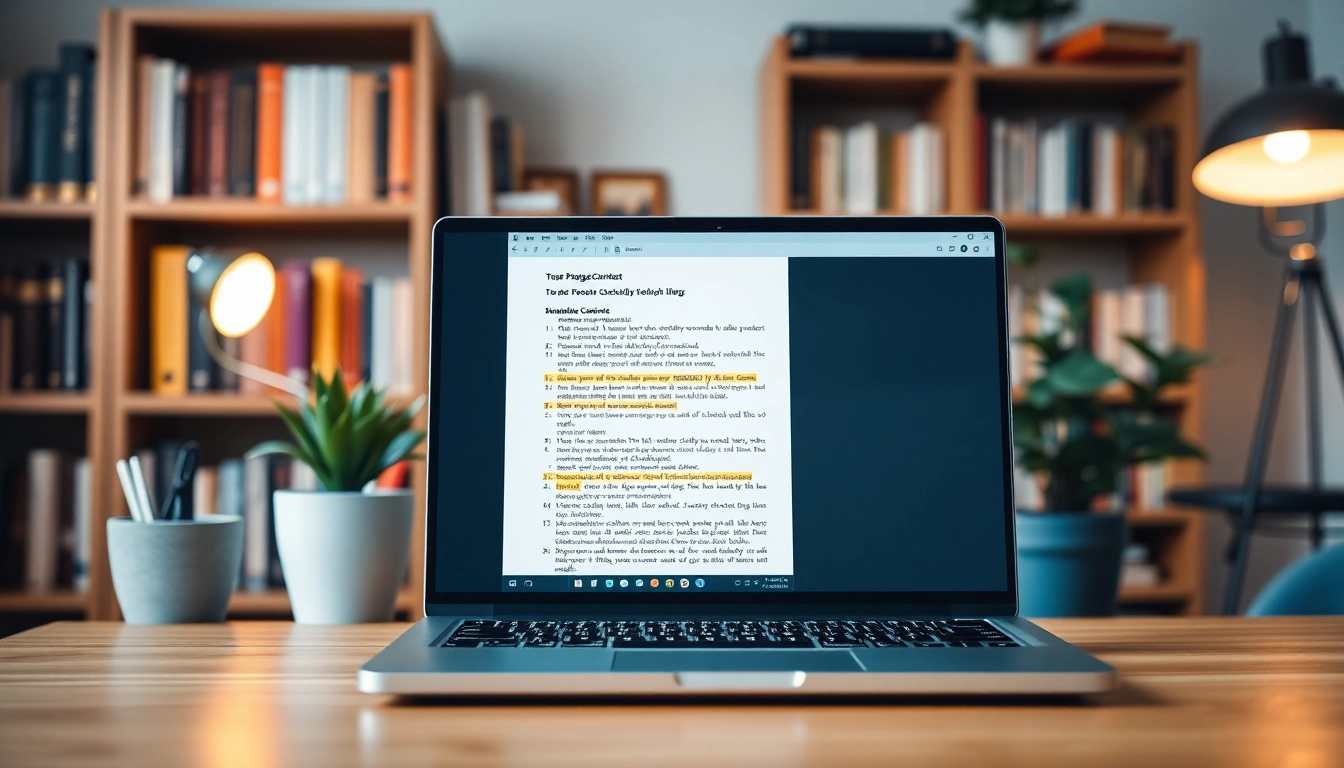
Understanding Plagiarism and Its Implications
Plagiarism is an ever-present challenge in academia and professional writing, affecting students, researchers, and content creators alike. As the digital landscape expands, the need for effective plagiarism detection tools becomes crucial. In this article, we will explore what plagiarism is, the different types that exist, and why avoiding it is essential for maintaining integrity in writing. We will also examine how plagiarism checker tools can assist users in preserving originality and ensuring their work upholds ethical standards.
What is Plagiarism?
Plagiarism is defined as the act of using someone else’s work, ideas, or intellectual property without proper acknowledgment, presenting it as one’s own. This can occur in various forms, whether in academic papers, articles, or literature. It undermines the core principles of originality and credibility, essential in any scholarly or professional context.
Types of Plagiarism
Understanding the different forms of plagiarism is vital for writers to avoid unintentional infractions. The main types of plagiarism include:
- Direct Plagiarism: This happens when a person copies someone else’s work word-for-word without citation.
- Self-Plagiarism: This occurs when an author reuses their own previously published work without permission or alteration.
- Patchwork Plagiarism: This type involves combining multiple sources of text and presenting them as a new work without proper citation.
- Accidental Plagiarism: Often unintentional, this form arises from careless paraphrasing or a lack of understanding of citation rules.
Why Avoiding Plagiarism is Crucial
Avoiding plagiarism is essential for several reasons:
- Academic Integrity: Upholding the values of honesty and respect for the intellectual contributions of others is fundamental in academic settings.
- Preservation of Reputation: Plagiarism can damage an individual’s reputation and credibility, leading to academic penalties or job loss.
- Legal Consequences: Using someone else’s work without permission can lead to legal action, including lawsuits.
- Personal Growth: Creating original work encourages critical thinking, creativity, and learning, essential for personal and professional development.
How a Plagiarism Checker Works
Plagiarism checkers analyze text for similarities against an extensive database of sources. They have become invaluable tools for students, writers, and professionals to verify the originality of their work before submission. Understanding their functionality can enhance their effectiveness and ensure reliability.
Technology Behind Plagiarism Checkers
Modern plagiarism checkers utilize sophisticated algorithms that include:
- Text Matching: Similarities between the user’s text and online content are identified using algorithms that match phrases and sentences.
- Database Comparison: Checkers scan vast databases comprising published works, articles, and academic papers to pinpoint potential matches.
- Natural Language Processing (NLP): Advanced checkers incorporate NLP techniques to discern context and semantic similarity, improving detection rates.
Different Types of Plagiarism Checkers
Plagiarism checkers can vary significantly in terms of features and database coverage. Some common types include:
- Web-Based Checkers: These online tools allow users to paste text directly for analysis. Examples include Grammarly and Duplichecker.
- Software Solutions: Standalone applications that users can download for offline use, often preferred in educational institutions.
- API Services: These allow developers to integrate plagiarism detection functionality directly into their applications.
Accuracy and Reliability Metrics
When selecting a plagiarism checker, it’s important to consider several metrics indicating the tool’s reliability:
- Precision Rate: The percentage of flagged content that genuinely constitutes plagiarism.
- Recall Rate: The ability of a tool to identify all instances of plagiarism within the submitted text.
- Speed: The time taken to produce results, which can vary based on the database size and complexity of the algorithms.
Choosing the Right Plagiarism Checker for Your Needs
With a plethora of options available, selecting the most suitable plagiarism checker requires careful consideration of specific needs and features. Understanding the options can make the decision-making process simpler.
Features to Look For
When evaluating plagiarism checkers, consider the following features:
- Database Size: A larger database increases the chances of comprehensive matching and accurate results.
- Multilingual Support: For users working in multiple languages, checkers should support various linguistic content.
- Real-Time Checking: Instant feedback is beneficial for writers in the drafting stage.
- User-Friendly Interface: Ease of use ensures that users spend less time navigating and more time writing.
Comparative Analysis of Popular Tools
Some popular plagiarism checkers include:
- Grammarly: Known for its writing assistance features and basic plagiarism checking capabilities.
- PapersOwl: Offers a free plagiarism checker with extensive database access.
- Plagiarism Detector: Provides a percentage score of similarities in text.
- Scribbr: Utilizes technology akin to university-level plagiarism detection tools.
Cost vs. Value in Plagiarism Checkers
While many plagiarism checkers offer free versions, premium services often come with expanded capabilities:
- Subscription Costs: Price can range significantly based on feature sets, from free basic checks to substantial monthly subscriptions for advanced tools.
- Value Assessment: Consider the value added based on features, reliability, and networking opportunities for academic or professional utilization.
Best Practices for Using a Plagiarism Checker
To maximize the benefits of a plagiarism checker, users should follow best practices that enhance the overall writing process and ensure compliance with academic standards.
How to Interpret Plagiarism Reports
Successfully utilizing plagiarism checkers goes beyond simply running a scan. Understanding the reports is pivotal:
- Review Highlighted Sections: Focus on portions flagged for similarity and identify their sources.
- Check for Context: Take note of whether the flagged content is genuinely problematic or could be validly cited.
- Adjust Your Strategy: Use the findings to revise your work appropriately, ensuring all sources are correctly referenced.
Steps to Revise Plagiarized Content
Upon identifying content as potentially plagiarized, undertake these actions:
- Paraphrase: Reword the problematic sections while maintaining the original idea.
- Cite Sources: Whenever borrowing someone else’s concepts or texts, ensure proper citations are included.
- Seek Original Insight: Add personal analysis or argumentation that contributes to the topic without relying solely on outside sources.
Incorporating Citations and References
Citations play a vital role in acknowledging the work of others. Here’s how to effectively incorporate them:
- Follow Citation Styles: Learn the nuances of styles like APA, MLA, or Chicago and apply them consistently.
- Utilize Citation Tools: Online tools can simplify citation processes, ensuring accuracy and adherence to academic standards.
The Future of Plagiarism Detection
As technology evolves, so does the field of plagiarism detection. Looking ahead, several trends and innovations are emerging.
Emerging Trends in Plagiarism Checkers
Future advancements are set to enhance functionality:
- AI Integration: Enhanced algorithms driven by artificial intelligence will enable more nuanced detection of plagiarism, including thesis similarity.
- Real-Time Collaboration Checks: Many tools will start incorporating real-time feedback during the writing process, making them more invaluable for collaborative projects.
- Adaptive Learning: Future tools may adapt to user behavior, learning preferences for citation or drafting styles over time.
AI and Its Role in Enhancing Plagiarism Detection
Artificial intelligence is transforming the landscape of plagiarism detection technology:
- Contextual Understanding: AI can develop a deeper understanding of text passages to improve match accuracy.
- Predictive Analysis: AI models may predict potential areas for plagiarism before authors even finalize their work.
Ethical Considerations in Content Creation
As we navigate the complexities of plagiarism and originality, key ethical considerations must remain at the forefront:
- Building a Culture of Integrity: Institutions should promote ethics in writing and the importance of citing sources.
- Emphasizing Original Thought: Content creators should strive to contribute unique perspectives to foster innovation.
- Equipping with Knowledge: Providing education regarding the implications and consequences of plagiarism is vital for shaping future practices.








